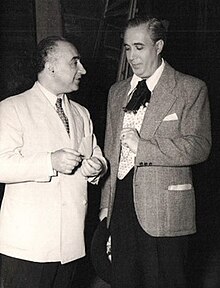Federico Moreno Torroba
Federico Moreno Torroba (born March 3, 1891 in Madrid ; † September 12, 1982 ibid) was a Spanish composer .
Life
Federico Moreno Torroba received his first music lessons from his father José Moreno Ballestro. Later he studied at the Conservatory of Madrid and was a student of Conrado del Campo .
Torroba initially composed symphonic works such as “Zoraida”, “Cuadros castellanos”, “La ajorca de oro”, “Capricho romántico” or the “Suite Castellana”. But Torroba soon followed his composer colleagues musically and turned to Zarzuela , helping her to flourish as one of the great composers of this genre in the 20th century.
The "Zarzuela" itself has some similarities with the French " opéra comique " and the German Singspiel or the operetta . One could say: the Zarzuela is the Spanish sister of the "operetta". Like this, the "Zarzuela" is characterized by alternating spoken and sung text.
plant
Torroba's first work was the opera “Las decicidas” and was premiered at the “Teatro Lara” in Madrid. In 1925 Torroba had great success with his first Zarzuela "La mesonera de Tordesillas". Sepúlveda y Manzona wrote the libretto . This work has a historical character and tells the adventures of the king "Felipe IV". Works like “Manola, la del porillo”, “La Marcharena”, “Cascabeles”, “Baturra de temple”, “El aguaducho”, “Azabache y la zarzuela” followed.
On March 31, 1931, "La chulapona" was performed for the first time. This score followed the popular Madrid line of Madrilena of “La Revoltosa” and “La verbena de La Palona”, the music for a popular religious festival in Madrid, celebrated on the eve of the patron mentioned . Torroba's best-known work "Luisa Fernanda" was premiered on March 26, 1932 in the "Teatro Calderón". Federico Romero and Guillermo Fernandéz Shaw wrote the libretto . This most famous work by Torroba has now been performed more than ten thousand times.
Spanish Civil War
The Spanish Civil War (1936) and the upcoming film put an end to the zarzuela's enthusiasm for the time being. The attempt of the Franco regime to stylize the Zarzuela into a national symbol met with rejection. It was only with the preparations for the 500th anniversary of the discovery of America (1982) that people remembered the musical legacy.
After this compulsory break, another new work by Torroba appeared: “Monte Carmelo”, in collaboration with the two librettists Romero and Shaw. There were also successes with “La Caramba”, premiered in April 1942 at the “Teatro de la Zarzuela”. Here was the librettist Luis Fernandéz Ardavin ; “La illustrious moza”, “Los laurelos”, “El cantar del organillo”, “Sierra Morena”, “Una noche en Aravaca”.
Music for guitar
In addition to his symphonic works, operas and zarzuelas, Torroba had the desire to create an independent, typically Spanish music, because he was - like z. B. also Manuel de Falla and many other Spanish composers - convinced of the importance of the guitar as a national instrument of Spain. In the course of his life he wrote about a hundred works for this instrument. Some of the works were suggested or commissioned by Andrés Segovia (who also recorded works by Torroba - such as Sonatina , Madronos and Suite Castellana - on record), but also other guitarists. He always composed in the spirit of Spanish folk music, as expressed, for example, in the headings of his eight “ Estampas ” (“pictures”) for four guitars: “Dancing a farmer's fandango - backwater - harvest - festival in the village - daybreak - Wedding - Mühlenweg - Childlike games. ”But also in works without such programmatic themes and motifs, such as B. the three-movement “ Sonatina ” for guitar and small orchestra, the musical themes and motifs speak a clearly Spanish language.
Torroba often proves to be a master of miniature in his sentences. In his “Puertas de Madrid”, “Pièces caractéristiques”, “Siete Piezas de Àlbum” or “Aires de la Mancha”. With regard to the compositional technique, he often used the song form ABA 'and the rondo form - from a formal point of view . The musical gesture is often cheerful, paints a picture of a sun-drenched landscape and flatters the listener with its dance-like rhythms.
Honors
In 1935 Torroba became a member of the Académico de Bellas Artes and in 1975 he was appointed President of the Sociedad de Autores Espanoles . For more than twenty years he was director of the “Calderón” and “de la Zarzuela” theaters in Madrid and of the Compania Lírica Nacional . The city of Madrid awarded Torroba the Consiguió la medalla de oro de la Villa de Madrid .
Catalog raisonné for guitar
- Concierto Ibèrico for guitar and orchestra (1976)
- Sonatina for four guitars and orchestra
- Estampas for four guitars
- Rafagas for four guitars
- Guitar solo
- Aires de la Mancha
- Anthology
- Burgalesa
- Nocturno
- 6 Pieces caracteristiques
- Preludio
- Serenata burlesca
- Sonatina
- Triptico, 3 pieces
- Punteado and Tacaneo Classico
- Jaraneira
- Suita castellana
- Puertas de Madrid
- Castillos de Espana
- Madronos
- Tres Preludios
Web links
- Works by Federico Moreno Torroba in the catalog of the German National Library
| personal data | |
|---|---|
| SURNAME | Moreno Torroba, Federico |
| BRIEF DESCRIPTION | Spanish composer |
| DATE OF BIRTH | March 3, 1891 |
| PLACE OF BIRTH | Madrid |
| DATE OF DEATH | September 12, 1982 |
| Place of death | Madrid |
